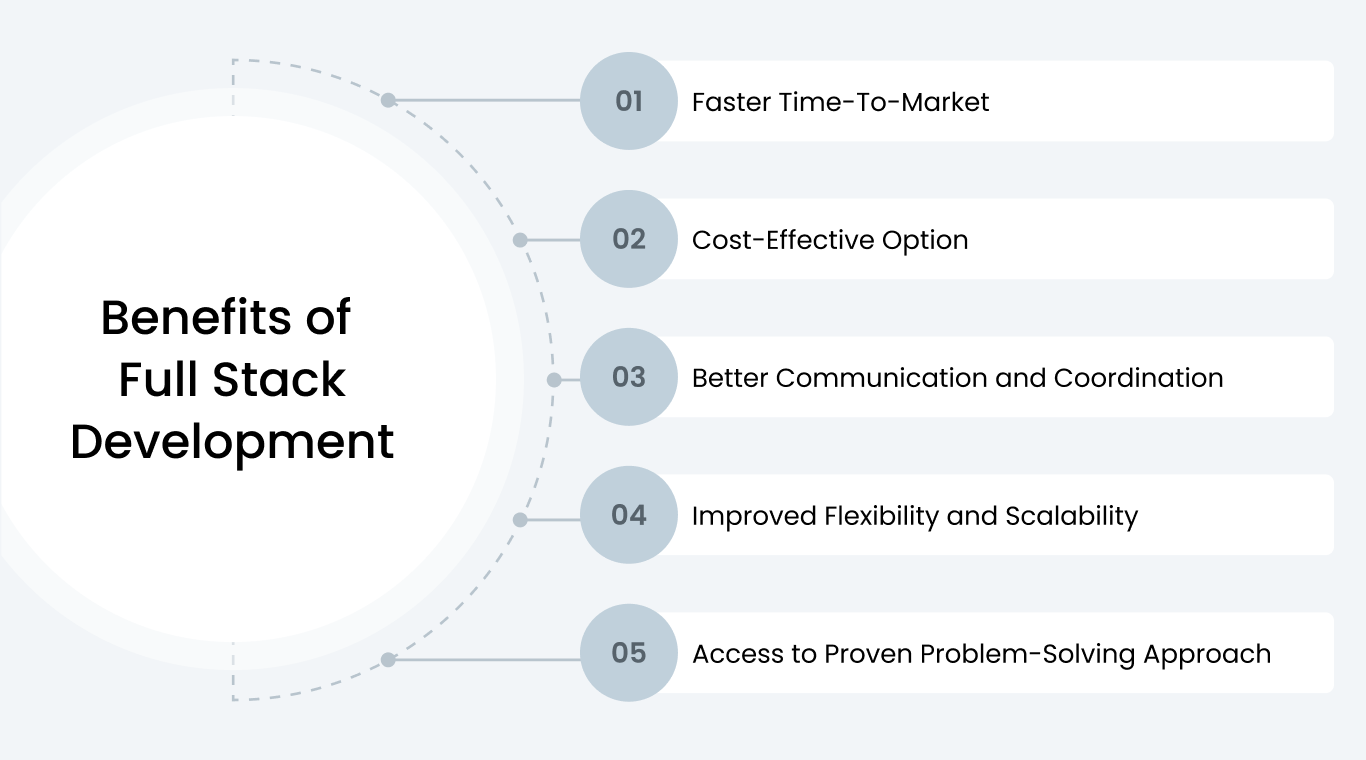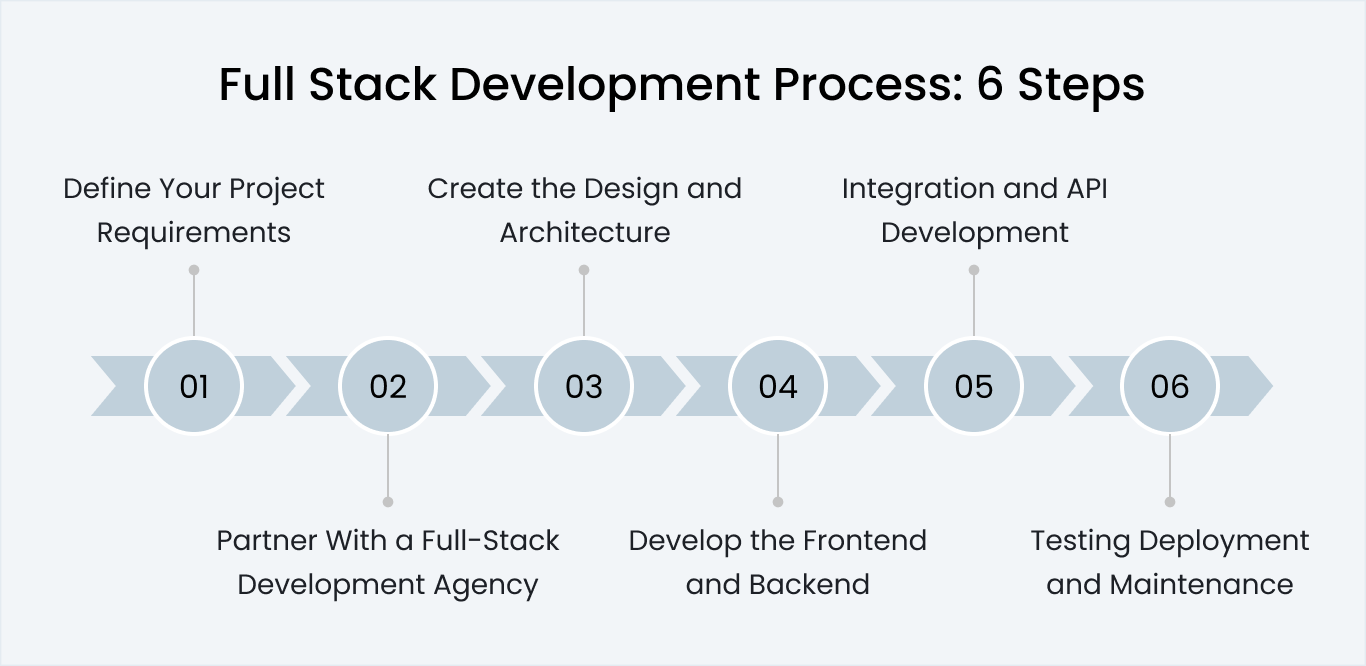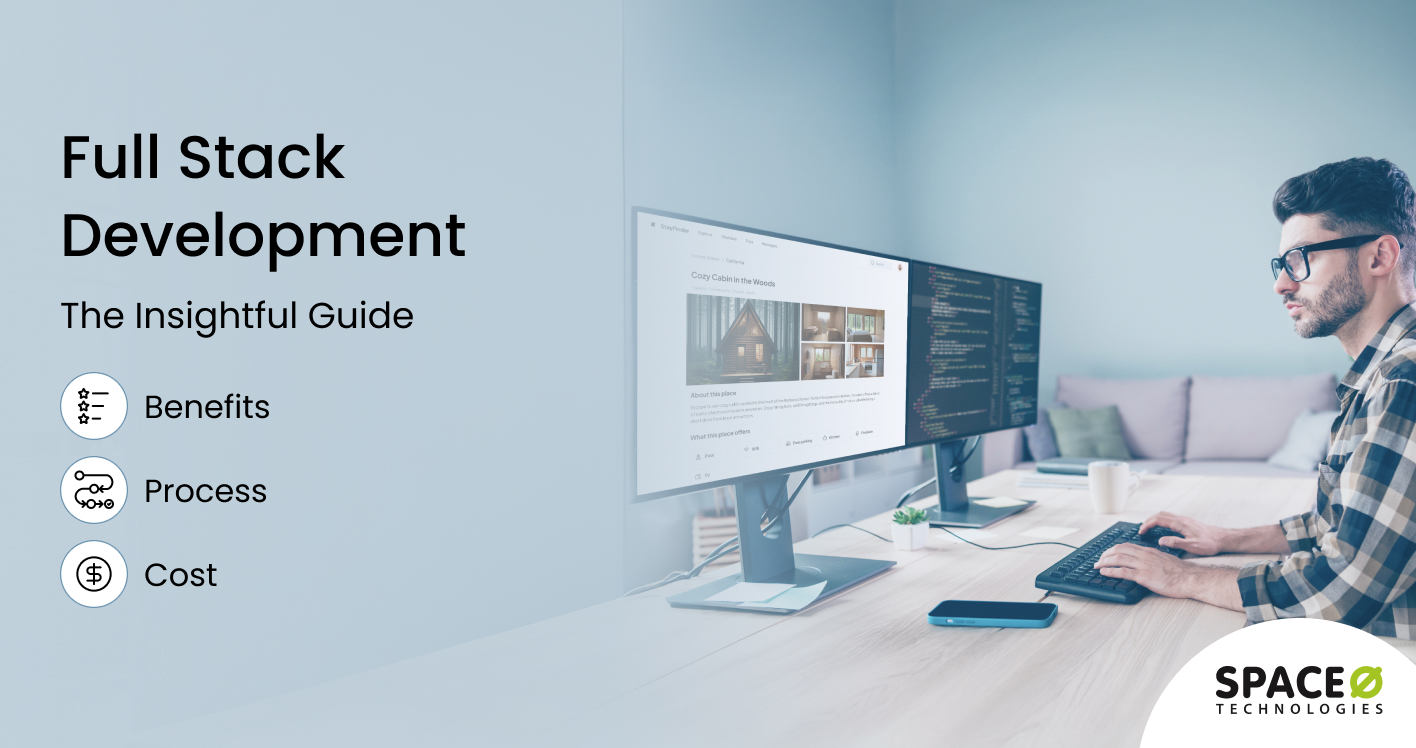Contents
Most businesses think they need a full-stack developer, but they actually need full-stack development services. There’s a big difference, and getting this wrong can cost you months of development time and tens of thousands of dollars.
As a leading Full-stack development services provider with over 15+ years of experience, Space-O Technologies understands the process, time, and cost involved in developing full-stack applications.
Based on our extensive experience, we’ve seen too many businesses struggle with fragmented development teams, delayed launches, and expensive rewrites.
That’s why we’ve created this guide that helps you understand:
- Why successful startups and enterprises choose full-stack development companies
- Complete process to develop full-stack applications
- Technology stack selection and best practices
- Cost breakdown and timeline estimation
- Advanced features and integrations
- How to choose the right development partner
So, here is an in-depth guide that solves all your queries about full-stack development services.
Before diving into implementation strategies and business benefits, let’s first establish a clear understanding of what full-stack development actually entails and what services you should expect from a professional development partner.
What is Full Stack Development?
Full-stack development is a process of web application development that involves working on both the frontend (client-side) and backend (server-side) components of an application. It involves a wide range of tasks, from designing user interfaces and user experience to managing databases, servers, and API integrations.
Full-stack developers are skilled professionals who can handle the complete development lifecycle of a web application, from concept to deployment and maintenance. They work with multiple technologies and frameworks to create scalable, secure, and efficient applications that meet specific business requirements.
For instance:
- React.js with Node.js for building dynamic web applications
- Angular with Python/Django for enterprise-level solutions
- Vue.js with Ruby on Rails for rapid prototyping and development
Full-stack development ensures seamless communication between all layers of an application, resulting in faster development cycles, better performance, and reduced costs.
Now that you understand the meaning of full-stack development, let’s explore the scope of comprehensive full-stack development services and how they differ from simply hiring individual developers.
What Does Full Stack Development Include?
When most founders think “full stack developer,” they picture one person who can handle everything from database design to user interfaces. That’s not wrong, but it’s incomplete.
Full-stack development services encompass the entire technology ecosystem your product needs:
- Backend development: This service involves API development, database architecture, server management, security implementation, and integration with third party services. Whether it’s Node.js, Python, Ruby, or Java, the backend team ensures your application can handle growth.
- Database management: This service includes database design, optimization, backup strategies, migration planning, and ensuring data integrity as your application scales. Teams work with both SQL databases, like PostgreSQL, and NoSQL solutions like MongoDB.
- DevOps and Infrastructure: This service covers cloud deployment, continuous integration/continuous deployment (CI/CD) pipelines, monitoring, security protocols, and scaling strategies. Full stack development teams typically work with AWS, Google Cloud, or Azure.
- Quality assurance: Developers offer quality testing services that include comprehensive testing strategies, including automated testing, manual testing, performance testing, and security auditing. This prevents bugs from reaching production and ensures your application meets quality standards.
Types of Full Stack Applications You Can Develop
| Application Type | Description | Common Features |
|---|---|---|
| E-commerce Platforms | Online retail and marketplace solutions | Product catalog, shopping cart, payment processing, order management, and inventory tracking |
| Social Media Applications | Social networking and content-sharing platforms | User profiles, news feed, messaging, content sharing, social interactions |
| Enterprise Management Systems | Business process automation and management tools | CRM, ERP, project management, reporting, workflow automation |
| Learning Management Systems | Educational platforms and online course delivery | Course management, user progress tracking, assessments, video streaming |
| Healthcare Applications | Medical practice management and telemedicine solutions | Patient records, appointment scheduling, telemedicine, prescription management |
| Financial Applications | Banking, fintech, and investment platforms | Account management, transaction processing, financial analytics, security features |
| Real Estate Platforms | Property listing and management systems | Property search, virtual tours, lead management, document processing |
| Travel and Booking Systems | Travel planning and reservation platforms | Booking management, payment processing, itinerary planning, review systems |
With these application types in mind, you’ll need to understand the technology foundation that makes them possible. Let’s explore the essential technology stack components that power successful full-stack applications.
Technology Stack Used in Full Stack Development
Choosing the correct technology stack for full-stack development is crucial for the success of your application. Here is a comprehensive technology stack for developing your full-stack solution.
| Components | Technology Options |
|---|---|
| Frontend | |
| Programming Languages | JavaScript (ES6+), TypeScript, HTML5, CSS3 |
| Frameworks & Libraries | React.js, Angular, Vue.js, Svelte |
| Styling Frameworks | Bootstrap, Tailwind CSS, Material-UI, Ant Design |
| State Management | Redux, MobX, Vuex, Context API |
| Backend | |
| Programming Languages | Node.js, Python, Java, Ruby, PHP, C# |
| Frameworks | Express.js, Django, Flask, Spring Boot, Ruby on Rails, Laravel |
| API Development | RESTful APIs, GraphQL, gRPC |
| Databases | |
| SQL Databases | MySQL, PostgreSQL, SQL Server, Oracle |
| NoSQL Databases | MongoDB, CouchDB, DynamoDB, Redis |
| DevOps & Deployment | |
| Cloud Platforms | AWS, Microsoft Azure, Google Cloud Platform |
| Containerization | Docker, Kubernetes |
| CI/CD | Jenkins, GitHub Actions, GitLab CI, CircleCI |
| Additional Tools | |
| Version Control | Git, GitHub, GitLab, Bitbucket |
| Testing Frameworks | Jest, Mocha, Cypress, Selenium, JUnit |
| Monitoring | New Relic, DataDog, Prometheus, Grafana |
| Web Servers | Nginx, Apache, IIS |
Now that you have a comprehensive understanding of what custom full-stack development encompasses, you might be wondering why businesses choose this approach over alternatives. Let’s examine the compelling benefits that make full-stack development the preferred choice for successful companies.
Top 5 Benefits of Outsourcing Full Stack Development Services

Here are the key benefits that explain why full-stack development outsourcing has become the go-to solution for businesses ranging from startups to enterprises.
-
Faster development and time-to-market
Full-stack development enables faster project delivery because a single team can work on both frontend and backend components simultaneously. This eliminates communication gaps between different teams and reduces development time significantly. With unified development processes, your application can reach the market faster, giving you a competitive advantage. -
Cost-effective solution
Hiring full-stack developers is more cost-effective than maintaining separate frontend and backend development teams. You need fewer developers to build a complete application, which reduces overhead costs, project management complexity, and resource allocation challenges. This approach provides better ROI while maintaining high-quality standards. -
Better communication and coordination
Full-stack development ensures seamless communication between all application layers. Since developers understand both client-side and server-side technologies, they can make informed decisions about architecture, performance optimization, and feature implementation. This results in better-integrated solutions and fewer technical conflicts. -
Enhanced flexibility and scalability
Full-stack applications are designed with scalability in mind from the beginning. Developers can make architectural decisions that support future growth, handle increased user loads, and accommodate new features efficiently. The flexibility to work with multiple technologies allows for better adaptation to changing business requirements. -
Comprehensive problem-solving approaches
Full-stack developers can identify and resolve issues across the entire application stack. They understand how different components interact, which enables faster debugging, better performance optimization, and more effective troubleshooting. This comprehensive approach results in more robust and reliable applications.
These benefits demonstrate why outsourcing full-stack development is an attractive option for businesses. However, understanding the “why” is just the beginning. The real value comes from knowing exactly how to implement full-stack development successfully for your specific business needs.
Skip the FullStack Development Headaches, Get Results Instead
Our experienced full-stack development team can help you build scalable, efficient applications that drive business growth. Let’s discuss your project requirements.

Now that you understand why it’s beneficial, let’s dive into the practical implementation guide. This section will walk you through the complete process, from initial planning to final deployment and beyond.
6-Step Process for Full-Stack Application Development

Below is a brief step-by-step process of developing a full-stack application in 6 steps.
Plan and gather your project requirements
First, thoroughly define the objective of your project, the problems it will solve, and the specific requirements needed to achieve business objectives.
- Clearly outline what your full-stack application will do and its core features
- Define the current challenges in your business and know how your solution addresses these pain points
- Identify the clear value proposition for your full-stack application
- Figure out any specific technologies or systems your application should integrate with
- Conduct market research to understand the competitive landscape and user expectations
- Identify possible technical risks that could impact your full-stack application development
- Prepare the necessary documentation, like technical specifications and user requirement documents
This should include:
This step provides you with a clear direction for your project. Planning ensures your goals align with successful full-stack application development.
Partner with a full-stack development company
Once you understand and gather your project requirements, you need to contact a reputable full-stack development company.
To develop a full-stack application, reach out to top-rated full-stack development companies.
One of the leading ones is Space-O Technologies, which provides end-to-end full-stack development services.But now the question arises, how would you choose a full-stack development company?
- Check the portfolio, case studies, and years of experience in relevant technologies like MEAN, MERN, and LAMP stacks
- Verify that the company is proficient in utilizing modern frontend and backend technologies
- Examine client testimonials and seek references from established businesses
- Ensure the company’s team size can handle your project scope and timeline
- Understand the cost structure and pricing models for full-stack development services
Create the design and architecture of your application
Once you have chosen a full stack development company, the Business Analyst team creates wireframes and designs the UI/UX of your application.
In this step, you’ll work closely with your design team and business analyst team to create a great user experience and application architecture for your project.
- Creating wireframes, prototypes, and system architecture that give a visual representation of your application’s layout and technical structure.
- Provide the list of the elements of the user interface (UI), such as colors, fonts, navigation flow, and overall look.
- Describe how the user experience (UX) should be designed and look to improve the engagement and meet user expectations.
The design process includes:
During the system architecture phase, the process involves designing the database schema, API structure, and selecting the appropriate technology stack for both frontend and backend development.
The combination of UI/UX design and technical architecture improves the usability and performance of your full stack application.Develop the frontend and backend of your application
Once the UI/UX design and system architecture of your full-stack application are ready, the development team begins building the frontend and backend components.
- Frontend Development: Frontend developers use modern technologies like HTML5, CSS3, and JavaScript, along with frontend frameworks like React.js, Angular, or Vue.js to create responsive and interactive user interfaces. The frontend development process includes building visual components such as forms, buttons, navigation menus, and dynamic content that users interact with directly.
- Backend Development: Backend development involves creating server-side logic, database management, and API development. Backend developers use technologies like Node.js, Python, Ruby, PHP, or Java along with backend frameworks like Express.js, Django, Laravel, or Spring Boot to build a robust server architecture that handles business logic, data processing, and third-party integrations.
Your application goes through multiple development phases and code reviews during the entire development process until the finished functionality is delivered. A dedicated project manager defines milestones and ensures the timely delivery of your full-stack web application.
Integration and API development
During this step, the development team focuses on connecting the frontend and backend components through well-designed APIs (Application Programming Interfaces). This step ensures seamless data flow between the user interface and server-side logic.
- RESTful API development for standard web services
- GraphQL implementation for efficient data querying
- Third-party API integrations (payment gateways, social media, cloud services)
- Database optimization and data migration processes
- Security implementation, including authentication and authorization
- Real-time features using WebSocket or Server Sent Events
Here’s what happens during this phase:
The integration phase is crucial for creating a cohesive full-stack application that performs efficiently and provides a smooth user experience across all functionalities.
Testing, deployment, and maintenance
In the final phase, you ensure that your full-stack application meets the highest standards including security and performance requirements.
The outsourced full-stack web development team carries out multiple types of testing, including unit testing, integration testing, performance testing, and security testing, to identify and fix any issues.
The application is deployed to production servers using modern web app development practices, containerization with Docker, and cloud platforms like AWS, Azure, or Google Cloud.
Space-O Technologies has the expertise to develop full-stack applications such as Glovo (a $1.2B unicorn delivery app), Fyule (eLearning platform with $1.4M funding), and GPT Vix (AI recruitment software). We use Agile methodology and Scrum frameworks for developing full-stack solutions that meet your specific requirements.
We understand that this is a difficult task, and if you do not want to spend time looking for an appropriate company, our fulllstack development team is here to help you.
Note: Regularly monitor and maintain the performance of your software or web application, including performance optimization, security updates, feature enhancements, and technical support to ensure long-term success.
Having a solid development process is essential, but selecting the right development partner can make or break your project. Let’s explore how to evaluate potential partners and avoid common pitfalls that could cost you time and money.
Turn Your App Idea Into Reality in Just a Few Months
Stop planning and start building. Our proven 6-step process has launched 300+ successful applications and helped startups to enterprises, which are listed on the Fortune 500 list.
How to Evaluate Full Stack Development Partners
This is where most founders make critical mistakes. They focus on technical skills and portfolios but miss the business alignment factors.
- Technical competency: Any serious development partner should demonstrate expertise across the full technology stack, show examples of scalable applications they’ve built, provide case studies with measurable results, and have established quality assurance processes.
- Business understanding: This quality separates good developers from great development partners. Look for teams that ask about your business model, understand your target market, suggest feature prioritization based on user value, and can articulate how technical decisions impact business outcomes.
- Process and communication: This quality helps you determine project success more than raw technical ability. Evaluate their project management methodology, communication frequency and clarity, how they handle scope changes, and their approach to timeline management.
- Post-Launch support: Understand their maintenance and support offerings, how they handle performance monitoring, their approach to feature updates and scaling, and what happens if issues arise after launch. Like Space-O, it offers 90-day software maintenance and ongoing support services after deploying the project successfully.
- User registration/login
- Basic dashboard
- CRUD operations
- Responsive design
- Basic API integration
- Advanced user management
- Real-time notifications
- Payment gateway integration
- Third-party API integrations
- Admin panel
- Analytics dashboard
- Microservices architecture
- Advanced security features
- AI/ML integration
- Custom reporting system
- Multi-tenant support
- Scalable cloud deployment
- Team size and experience level
- Project scope and feature complexity
- Integration requirements with existing systems
- Third-party API dependencies
- Deployment and infrastructure setup
- Post-launch support and maintenance planning
- Prioritize business outcomes over technical trends: Instead of chasing the latest frameworks, our software development company selects proven technology stacks that align with each client’s specific business timeline and growth strategy.
- Invest in upfront planning and user research: The first thing we do after onboarding the client is to conduct research about the project, its scope, needs, and the client’s goals. It enables our full-stack developers, designers, and QA teams to leverage their expertise and experience effectively.
- Architect and deploy scalable applications: The team designs systems anticipating post-launch iterations. Recognizing that successful products typically undergo significant changes within their first six months.
- Focus on solving real-world challenges: Space-O chooses partnerships based on business compatibility, not just technical expertise. The company maintains that even perfect code fails if it doesn’t solve real business challenges.
Space-O Technologies has successfully deployed over 300 projects and served 1200+ clients across various industries, achieving a 98% project success rate. This highlights how this custom development focuses on project success while maintaining the quality and the client’s success.
-
Here’s a red flag I’ve noticed: Development partners who immediately jump into technical solutions without understanding your business context usually deliver technically sound but commercially irrelevant products.
Once you’ve identified the right development partner, the next critical decision is to determine how much it costs to develop the full-stack web application and the factors that affect everything from development speed to long-term maintenance costs.
How Much Does It Cost to Develop a Full Stack Application?
As you may already know, the cost to develop a full-stack application depends on various factors such as application complexity, features and functionalities, technology stack used, development team location, and project timeline.
To help you understand better, let’s look at the cost breakdown based on two factors:
Cost based on project application complexity
| Application Complexity | Cost Estimation | Features Included |
|---|---|---|
| Simple Full Stack App | $30,000 – $60,000 | Basic CRUD operations, User authentication, Responsive design, Simple dashboard, Basic API integration |
| Medium Complexity App | $60,000 – $120,000 | Advanced user management, Real-time features, Third-party integrations, Payment processing, Admin panel, Analytics |
| Complex Enterprise App | $120,000 – $300,000+ | Microservices architecture, Advanced security, Multi-tenant support, AI/ML integration, Custom reporting, Scalable infrastructure |
Cost based on development team location
| Country/Region | Average Hourly Rate |
|---|---|
| United States | $100 – $200 |
| Western Europe | $80 – $150 |
| Eastern Europe | $40 – $80 |
| India | $20 – $50 |
| Latin America | $30 – $70 |
**However, the actual costs can vary based on specific project requirements, developer experience, and other considerations. Learn more about web app development cost factors.
For an accurate estimate, it’s recommended to consult with experienced full-stack development companies.
Get Your Exact Project Cost in 48 Hours
No more guessing games or hidden surprises. Receive a detailed project breakdown with transparent pricing, realistic timelines, and guaranteed deliverables.
Understanding costs is just one part of project planning. Equally important is having realistic timeline expectations that align with your business goals and market opportunities.
How Much Time Does it Take to Develop a Full Stack Application?
Just like cost, the timeline for full-stack application development depends on multiple factors, including complexity, features, team size, and overall project scope. To give you a better idea, here’s the approximate timeline based on application complexity:
Here’s the approximate timeline based on application complexity:
| Application Complexity | Features and Functionalities | Development Timeline |
|---|---|---|
| Simple Full Stack App | 3-6 months | |
| Medium Complexity App | 6-9 months | |
| Complex Enterprise App | 9-18 months |
Factors affecting development timeline:
You now understand full-stack development: what it involves, its benefits, the process, cost, and how to select the right partner. Here’s how Space-O Technologies can help you turn this knowledge into a successful application for your business.
With this complete understanding of full-stack development, from core concepts and benefits to implementation strategies and expert insights. You’re equipped to make informed decisions about your project and transform this knowledge into business results.
Build Your Full Stack Application with Space-O Technologies
From this comprehensive guide, you have understood the complete process, benefits, costs, timeline, and best practices for full-stack development.
If you are looking for a company that can optimize your business processes and help you deliver custom full-stack web and software solutions, your search ends here. We are here to help, having served a variety of industries and maintained a worldwide client base of over 1200 satisfied customers.
Transform Your Problem into a Solution With Our Full Stack Excellence
Ready to build an application that drives real growth? Let’s discuss how our 14+ years of expertise can turn your vision into a market-leading solution.
Frequently Asked Questions About Full Stack Development
How does full-stack development benefit my business compared to hiring separate teams?
Full-stack development reduces costs by 30-40% compared to separate frontend and backend teams. It eliminates communication gaps, accelerates development cycles, ensures better integration between application layers, and provides unified project management. This approach delivers faster time-to-market while maintaining consistent quality standards.
How do I choose the right technology stack for full-stack development projects?
Technology stack selection should align with your business requirements, scalability needs, development timeline, and future maintenance considerations. Consider factors like team expertise, availability, integration requirements, industry standards, and long-term growth plans. Consult experienced developers to make informed decisions based on specific project needs.
Can full-stack applications be scaled for enterprise-level usage?
Yes, full-stack applications support enterprise scalability through microservices architecture, load balancing, database optimization, cloud deployment, and containerization. Modern frameworks and cloud platforms provide auto-scaling capabilities, performance monitoring, and resource management tools that handle increased traffic and data processing effectively.



